Visit to Kürnbach, Germany
The
Ancestral Village of the Garn Family
15-17 September 2012
by
Lynn E. Garn, Ph.D.
The train that my brother Stan and I took from Paris to Frankfurt arrived at just before 1300hrs on Saturday, 15 September. Our trip from the train station to the airport, where the travel agent had reserved our car, took a while. So it was around 1400hrs before we had the rental car. Fortunately we added a GPS navigation system to the rental to make it easier to find our way around. Stan, having lived in Germany for seven years, already knew all of the major roads. However, we intended to visit some places like Kürnbach and places in eastern France and Belgium. So we felt the navigation system would be money well spent. We left the airport heading almost straight south past Heidelberg and a couple hours after departing the airport we arrived in Kürnbach.
In late May or early June of 2010, I discovered that our Garn ancestors had lived in Kürnbach and had come to America in the mid to late 1700s. In Kürnbach the name of the Garn family was spelled Gern. But there is no doubt that it is the same family. The evidence appears in my book, The Garn Family including Carn, Garnes, Garns and Gern. From the time I discovered that Kürnbach was the ancestral village of the Garn family, I wanted to visit the village, walk the streets, stay in a guest house, eat at the restaurants, visit a vineyard, visit the church where their births and christenings were recorded, and see their names in those the old record books at the church. So I was quite excited when we arrived at the village.
The map below shows where Kürnbach is located in Germany. Most of the Germans who
left Germany to come to America left to escape religious persecution. The region in Germany that
most of them came from was known as the Palatinate. Technically Kürnbach doesn't appear to
be in the region known as the Palatinate. However it is close. We don't know for certain why our
ancestors left Germany. However, it is likely that they left for religious reasons.
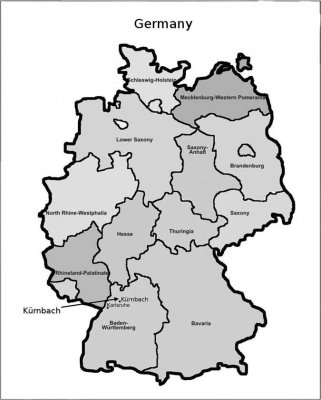
Map Showing The Location Of Kürnbach
The GPS coordinates of Kürnbach are 49.078104N, 8.845232E. Click on the coordinates to see the location on Google Maps. These coordinates point directly to the village square in front of the city hall. The old Evangelische or church is located on the north side of the square.
Kürnbach is so small that many Americans who have visited and even have lived in Germany have no idea where Kürnbach is located. However, most Americans who have been to Germany know where Heidelberg is located. And many also know where Karlsruhe is located. Karlsruhe is also shown on the map above. Kürnbach is located about 30 miles south-southeast of Heidelberg. And it is about 25 miles east-northeast of Karlsruhe.
A German friend, Karlheinz Bers, had made reservations for us at the Kürnbacher Hof,
a guest house in Kürnbach. The picture below shows me standing in front of the guest
house. Like most of the buildings in the middle of the village, it has the half-timber design
that was used more than 500 years ago. I don't know how old the Kürnbacher Hof is. A book
about guest houses that is mentioned below indicates there was an inn with a vaulted celler on
the site as early as 1465.
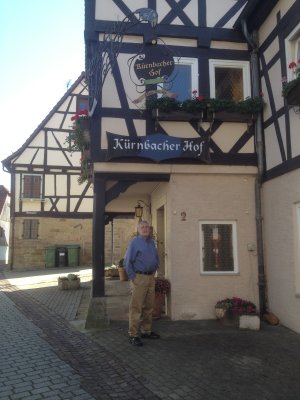
Me In Front Of The Kürnbacher Hof
The pictures below show two more views of the Kürnbacher Hof. The picture on the
right shows the vaulted celler or archway mentioned above.
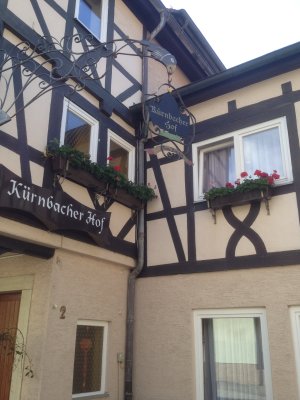
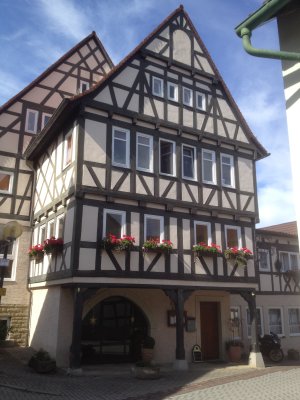
View Of The Kürnbacher Hof
Another View Of The Kürnbacher Hof
The Kürnbacher Hof is a typical guest house like you would find in other small
villages in Germany. It is clean, well run, and designed to make guests feel at home. For
anyone who wishes to visit Kürnbach and stay the night, I would recommend staying
at the Kürnbacher Hof.
A well-known local historian and author, Reinhard Schmid, from the Kürnbach area has
written many books about the history of the area. One book that he wrote was titled, "Alte
Gasthäuser erzählen Geschichten: Bretten, Diedelsheim, Flehingen, Kürnbach,
Oberderdingen, Sulzfeld" which translates to something like, "Old Inn Stories from Bretten,
Diedelsheim, Flehingen, Kürnbach, Oberderdingen, and Sulzfeld." These villages are
all clustered within about eight miles of each other. Pages 183 - 189 of this book tell
about the Kürnbacher Hof.
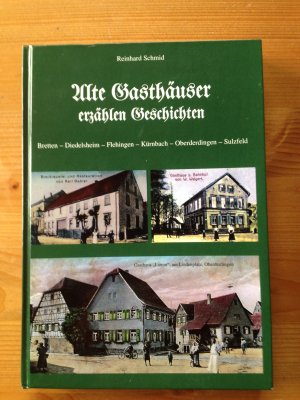
Book About Village Guest Houses
The picture below is the view out the window of my room at the Kürnbacher Hof.
The green along the far wall is a grape vine. In the foreground one can see a black sign
for the guest house. And below one can see the brick streets that characterize the center
of the village.
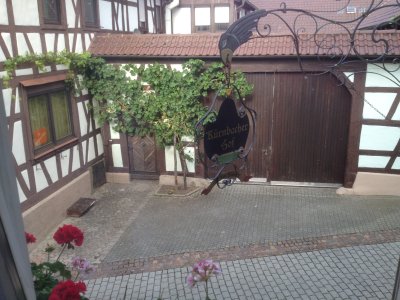
View Out My window At The Kürnbacher Hof
The picture below shows one of the dining areas in the Kürnbacher Hof. The kitchen
is barely visible through the far doorway. One thing I love about Germany is the breakfasts that
they serve in guest houses. And the breakfasts at Kürnbacher Hof were no exception. Stan
and I had excellent breakfasts both mornings we were there. We also ate two excellent dinners in
this room the two evenings we were there. Another large room in the guest house is used for large
parties and receptions.
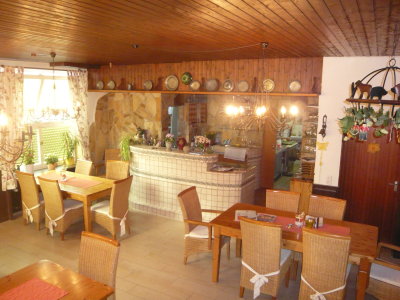
Kürnbacher Hof's Kitchen And Dining Area
The picture below is me with Frau and Herr Binder. Manfred Binder is the chef. And as noted
above, the meals were excellent. The Binders have owned and operated the Kürnbacher Hof for
several years.
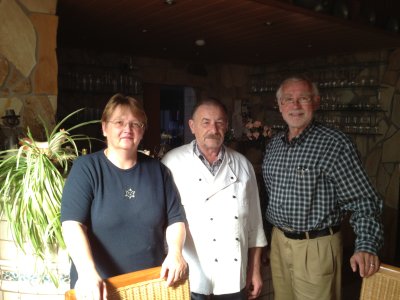
Me With Frau And Herr Binder Of The Kürnbacher Hof
I can't say enough about the wonderful reception that the Binders gave us at the Kürnbacher
Hof. They made us feel welcome in the guest house and the village. Although Herr Binder did not speak
very much English, we were able to communicate enough to get by. Frau Binder speaks English as do
their children. We met their son Wolfgang and their daughter Alecia. Stan met another daughter.
The Binders have a web site for the Kürnbacher Hof which may be visited by clicking here. If you paste the URL/address into Google Translate, it will translate the pages into English.
After checking into the Kürnbacher Hof, Stan and I decided to walk around the village to see
some things. As we were driving into the village, we noticed a large gathering of people at a building
near the center of town. It appeared as though there were more than 100 people. Being curious, we
approached the edge of the group and asked if anyone spoke English. The person with whom we spoke
indicated that he would get someone to speak with us, whereupon he went off and brought the man pictured
with me in the photo below. His name is Ralf Svoboda and we talked for some time, learning that he had
just returned from the United States and loved everything about the US. You can see from his hat and
tie that he does. It was only after we had talked for a while that we learned the gathering was actually
a reception for Ralf and his wife who had married about three months before and had spend the time
since their marriage in the United States. They had just returned and were attending a reception given
in their honor.
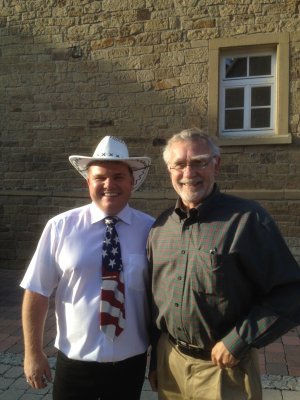
Me With Ralf Svoboda
Notice His Hat And Tie
We had a really good time talking with Ralf and others at the reception. They had to get pictures with
us and we got the picture above with him. Another person we spoke with at the reception was Claudia
Martus-Ehrmann. She is an English teacher in a nearby village. I believe she said she taught high-school age
students. As you would expect of any English teacher in Germany, her English was excellent. She was quite
interested to know that we were visiting the village because I had traced our family roots back to the
village.
It is probably worth noting here that we had no problems communicating with the people in the village. As we walked around that Saturday afternoon, on Sunday, and again on Monday morning, we frequently saw groups of three or four people. When we approached them and asked them if they spoke any English, one of them invariably would answer, "A little." Then the person would proceed to speak in excellent English that put to shame any German that we thought we could speak. The point here is that they were always willing to talk with us in English and that we were usually able to communicate at some reasonable level.
Near the site of the above mentioned reception is a wall next to which were growing several grape
vines. Kürnbach is well known for the wine produced in the area. There were signs with the grapes
growing by the wall showing the varieties of grapes that are grown by the vintners in the area. The
pictures below show the types of grapes grown in the area. The Muskat Bleu grape may be the one that
they use to make the Schwarzriesling or Black Riesling wine that the region is known for. That wine is
hard to find in the United States. I know because I've looked for it at a lot of places. The French also
make the wine and market it by the name Pinot Meunier, which is easier to find.
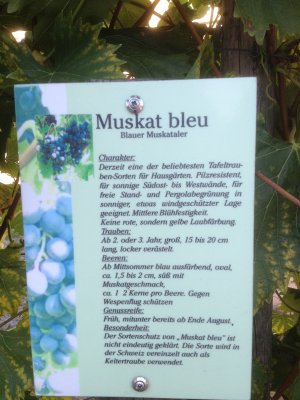
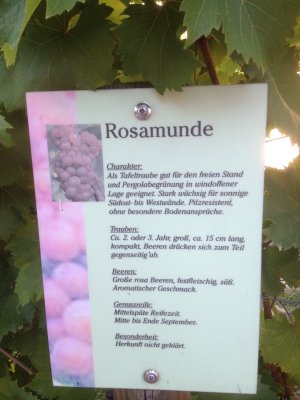
Information About
Muskat Bleu GrapesInformation About
Rosamunde Grapes
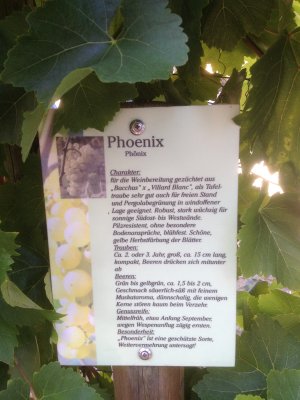
Information About Phoenix Grapes
Later in this story I tell how we got some of the Muskat Bleu grapes. They were really great.
I'd love to be able to grow them myself.
The picture below shows one of several beautiful wrought iron designs that can be found in
the village. This was at the site of a former Hessian guesthouse, "Zum Lamm," Note the flowers,
angel blowing the trumpet, bird, sheep and flag.
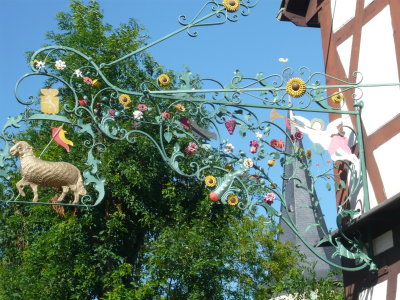
Ornate Wrought Iron Decoration
The picture below is the Rathaus or City Hall. On Monday morning we stopped there hoping to speak with Frau Elke Dörlich, a lady that Stan had spoken with two years ago when he went to Kürnbach at my urging to take some pictures for my book on the Garn family tree. It was days after I had discovered that our Garn ancestors had come from Kürnbach and also just a few days before Stan was slated to move back to the United States. Frau Dörlich had been most helpful to Stan during his short visit two years ago. When we arrived at the City Hall, we discovered to our disappointment that Frau Dörlich would not be at work that day.
Having struck out in our attempt to speak with someone Stan had met with before, we decided to stop at the mayor's office to shake hands with him and tell him how much we loved the village. We stepped into the mayor's outer office and spoke with his secretary or assistant. We explained that we were visiting from the United States, that our ancestors were from Kürnbach and had left in the mid 1700s, that I had written a family tree book that included a section on Kürnbach as the family's ancestral home, and that we'd like to speak with the mayor for a moment. As we were talking with the secretary, we could see the mayor through the open door to his office. The secretary went into his office and spoke with him for a few seconds and then came back toward us closing his office door behind her as she left his office. She said that the mayor was familiar with my book and that he not available.
I couldn't believe he didn't have 30 seconds to see us and shake our hands. I couldn't help
thinking about my dad, a business man, and how he conducted himself in his business. Even if he
had been in the middle of some big task, he would have taken 30 seconds to shake the hand of
someone from another country, state or even neighboring county or town if a stranger had stopped
by his office to speak with him. Dad would have taken time to hear a few words that they had to say
and tell them it was nice to meet them. Some politicians could care less about people that they
know cannot vote them out of office.
The village of Kürnbach has a web site which may be visited by clicking
here. If you paste the URL/address into
Google Translate, it will translate the pages into English.
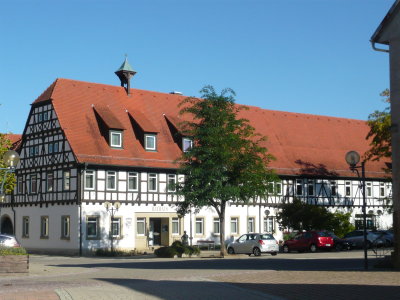
Rathaus Or City Hall
The picture below is the Gasthaus Krone or Krone Guest House. While we were in Kürnbach,
we had a lunch there. The food was good and we were treated well there also.
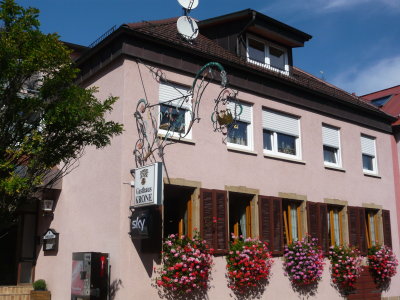
Gasthaus Krone
The most famous resident of Kürnbach is probably John Adam Treutlen, the first elected Governor of the State of Georgia in the United States after the Revolutionary War. He served as Georgia's Governor from May 1777 until January 1778. After his term as Governor, he got out of politics for a while. Then in early 1782 he decided to re-enter politics. However, in March 1782 five men rode up to his house, pulled him out and killed him in front of his family, possibly because of dissatisfaction among some over his re-entry into politics. The reasons for his murder are still not known for certain. Some speculate that he was killed by supporters of the British in the Revolutionary War who were angry over the outcome of the war and were seeking revenge.
John Adam Treutlen was born in Kürnbach in 1734 to Hans Michael Treutlen and Maria Clara
Job. His parents left Germany and came to Georgia in 1744 when John Adam Treutlen would have been
about 10 years old. The picture below shows the building that was owned by John Adam Treutlen's
father Michael or Hans Michael Tretulen. German naming conventions at the time dropped the first
name Hans. John Adam Treutlen's father would have been known as Micheal Treutlen in the community.
The inscription above the door indicates that the building belonged to Michael Treutlen and was
built in 1715. Although the first digit of the year looks peculiar, it really is a "1" and is an
example of the "1" that often appears as the first digit of a number. The name Treutlen also
appears as Treutle today.
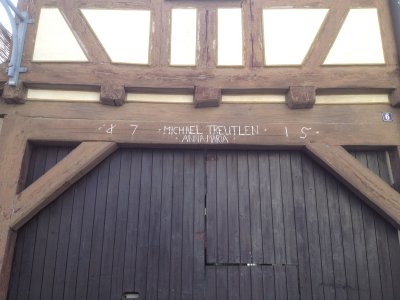
Home of Michael Treutlen
The picture below is of Stan in front of the home of Michael Treutlen.
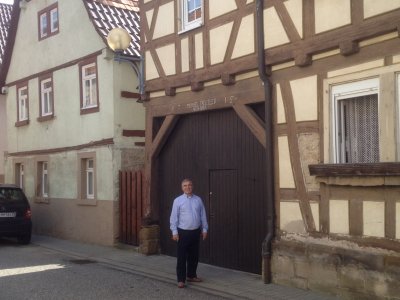
Stan At The Home Of
Michael Treutlen
The picture below is of me in front of the home of Michael Treutlen.
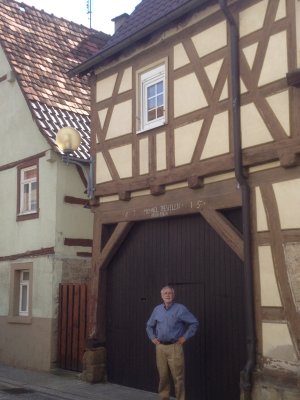
Me At The Home Of
Michael Treutlen
The village has a nice little stream running through it. And there are many foot bridges
that cross it. The picture below shows the stream and one of those foot bridges. Note the
steeple of the church in the background.
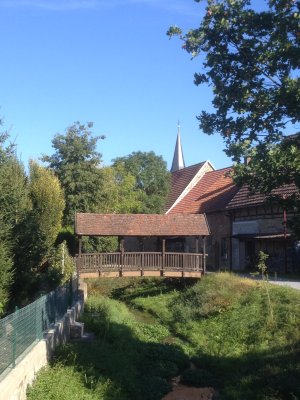
Bridge Over Stream Running Through Kürnbach
The picture below is Stan on one of the bridges going over the stream in Kürnbach.
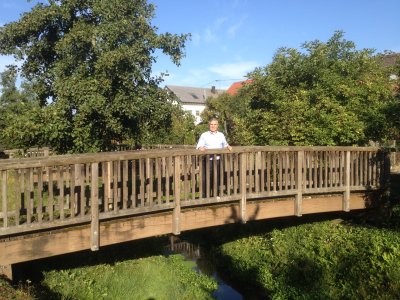
Stan On Bridge
The picture below is me on one of the bridges going over the stream in Kürnbach.
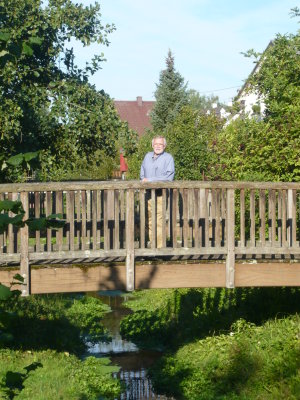
Me On Bridge
The pictures of the stream above suggest a slow stream with not a lot of water
passing under the bridges. However, on a few rare occasions the water level has gotten
high. The picture below shows a marker attached to the side of one of the buildings and
the high water marks for several years when the village flooded.
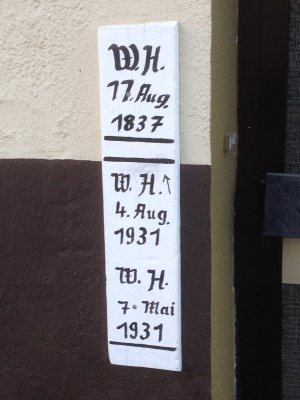
High Water Mark
I had to take a picture of this sign at the base of one of the buildings. It
indicates that the building was constructed in 1714. The reason this year is significant
is that this is the year that our ancestor Johann Adam Gern was born. Adam Gern, as he would
have been known, was the father of brothers Johannes Gern and Conrad Gern. Johannes
Gern was the John Garn who settled in Bedford County, Pennsylvania, and died there in
1808. His brother Conrad Gern settled in Franklin County, Pennsylvania, where descendants
today use the Garns spelling of the last name. Since Abraham Garn, grandson of Conrad Gern,
married his second cousin Susan Garn, the granddaughter of Johannes Gern, I am a
descendant of both Johannes and his brother Conrad Gern. The alert reader will notice the
unusual "1" used for the first digit of the date. This is similar to the unusual "1"
that appeared as the first digit of the date of the Michael Treutlen house discussed above.
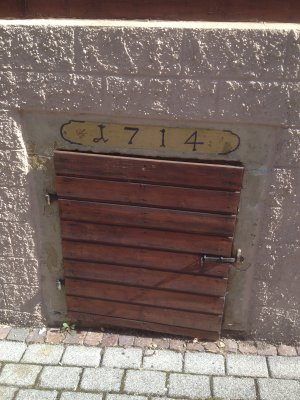
1714, Date Of Construction
The cute little half-timber house shown below intrigued us. It was probably the
smallest half-timber house in the village. And it was very well kept. When we first
saw it, the sun was casting a dark shadow across it. Still we photographed it to be sure
we got a picture. But we made a mental note to return later when the shadow would surely
have diminished. Each time we passed the house, we stopped admired it some more and
snapped another photograph. I suspect that the lady who lived there may have seen us
and become concerned. She clearly recognized that we were not residents of the village.
And it's even possible she could tell we were Americans. So it probably caused her
some concern. Later when my friend Karlheinz Bers and his wife Christine was walking
through the village, we passed by the home and the lady came out and spoke in German
with Karlheinz. During their conversation she told Karlheinz about an interesting little
rhyme or ditty that the children learned in grade school, which involved the Gern
family. That rhyme or ditty is given later.
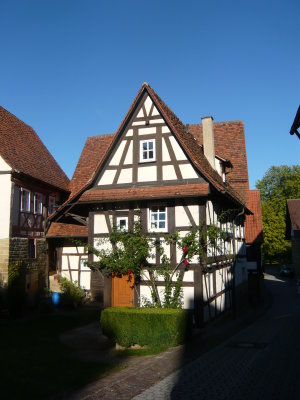
Cute Little Half-Timber House
At the time when the Gern or Garn family lived in Kürnbach, the center
of social activity in the village undoubtedly revolved around the church. The picture
below shows the church as it looks today. Parts of the church date back to when
our ancestors lived there.
The Evangelische in Kürnbach has a web site which may be visited by clicking
here. If you paste
the URL/address into Google Translate, it will translate the pages into English.
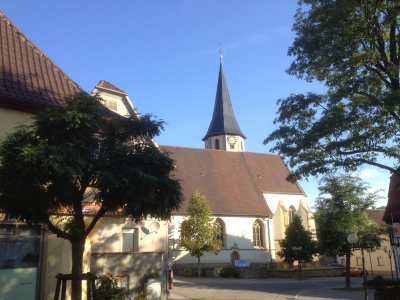
A View Of The Evangelische Or
Protestant Church in Kürnbach
Another view of the church
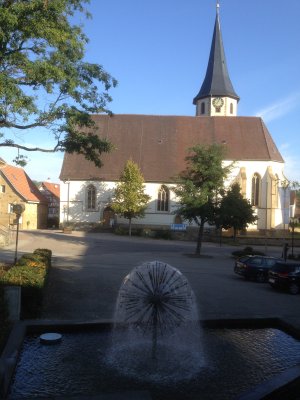
Another View Of The Evangelische Or
Protestant Church in Kürnbach
The pictures below show Stan and me with the Evangelische or Protestant
Church in the background.
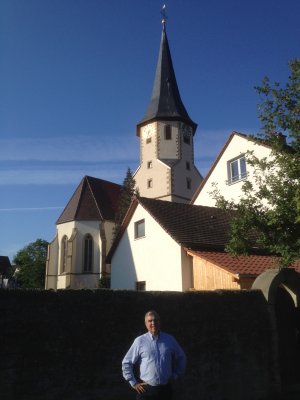
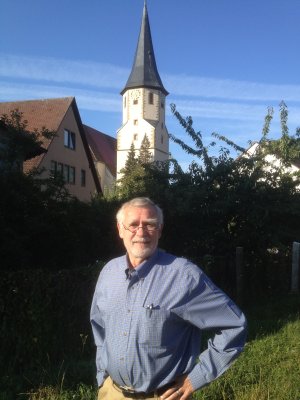
Stan At The Evangelische Or
Protestant Church in KürnbachMe At The Evangelische Or
Protestant Church in Kürnbach
The picture below is of the Evangelische or Protestant Church seen though
an archway near the church.
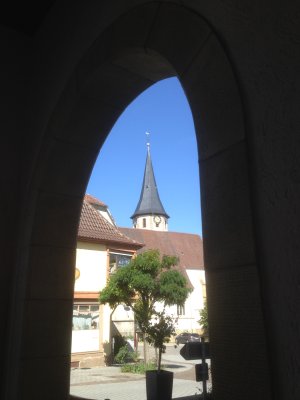
Another View Of The Evangelische Or
Protestant Church in Kürnbach
As soon as we realized that we would be in Kürnbach on a Sunday morning,
Stan and I decided we wanted to attend the Sunday morning church service at the
Evangelische. We had mentioned our intentions when we were talking with the Binders
at the Kürnbacher Hof. We were disappointed when they showed us the church
schedule on the local newspaper. Apparently the church shares the minister with
a neighboring village. And the minister, a woman named Frau Ulrike Trautz, was
scheduled to be at the neighboring church the Sunday morning we were in town.
Fortunately the church was still open. So we went inside to see what the church
looked like inside.
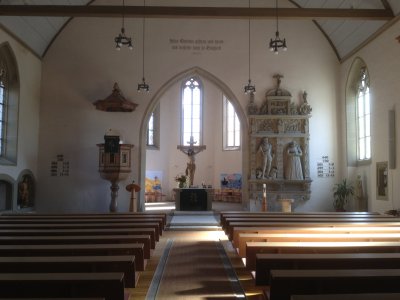
A View Of The Inside Of The Evangelische Or
Protestant Church In Kürnbach
Stan and I both had to have our pictures taken inside the church.
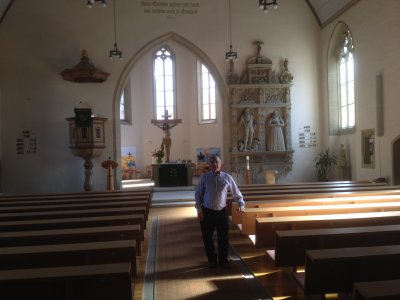
Stan Inside The Evangelische Or
Protestant Church In Kürnbach
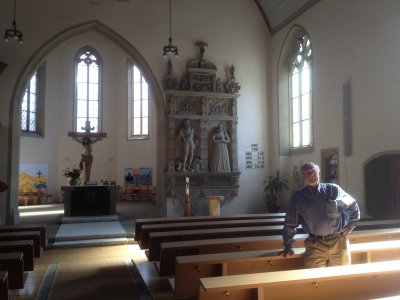
Me Inside The Evangelische Or
Protestant Church In Kürnbach
The picture below shows the front of the church as seen from the balcony of the church.
The art work on the right that shows a man and a woman is a sandstone carving dating from
around 1600 by an unknown artist. It depicts a local aristocrat, Bernard von Sternenfels and
his wife Maria Agatha von Weitershausen. It is believed that the Sternenfels married into
the Kürnbach family that had lived in the area from before the year 1250 and eventually
either died out or moved away. The house owned by the Sternenfels is now a private residence
in Kürnbach.
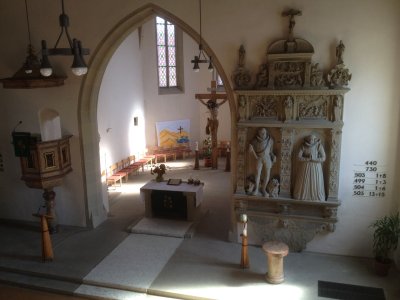
A Balcony View Of The
Inside Of The Evangelische Or
Protestant Church In Kürnbach
Before leaving the church, I made sure I signed the guest book in my best German, telling
people that we visited from the United States and that our ancestors were born in the village.
Later that afternoon when my German friend, Karlheinz Bers, saw what I had written, he corrected
a letter in one of my words. I think the letter I used gave a verb the wrong tense. I was glad
for the correction.
As we were walking around Kürnbach, we learned that there were two other churches,
a Methodist Church and a Catholic Church in the village. We stumbled upon the Methodist Chruch
several minutes after the service had finished. So we went in and found someone to talk with.
The picture below shows the Methodist Church.
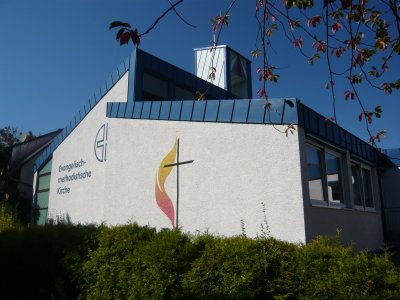
Methodist Church in Kürnbach
At the Methodist Church we spoke at length with the lady shown below. She was happy
to give us a tour of the entire church, showing us sanctuary, class rooms and the kitchen.
She also was happy to tell us of all the activities they had for children. At some point
during our talks, she sort of apologized for the size of the church, as though it might
seem smaller than we might have expected. Apparently she had some vision of large churches
in the United States and must have thought we probably expected a large church. Stan
explained to her that when we were children, we actually had gone to a very small country
church in the United States and that her church was much larger than the one we had grown
up with.
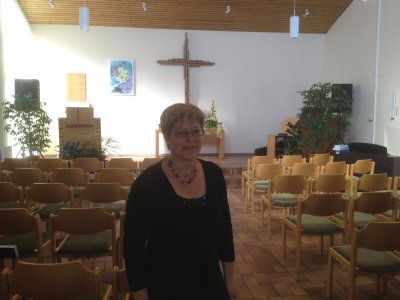
Methodist Church in Kürnbach
Earlier we mentioned that the region around Kürnbach is well known for it's wine and especially the Schwarzriesling wine or Pinot Meunier as the same wine is known in France. The region has been producing wine for many years. The oldest documents about Kürnbach are said to include references to wine grown in the region. And it is believed that the Romans introduced grapes and wine to the region when Rome ruled this part of Germany.
The birth and christening records of our ancestors give the occupations of the fathers of the children who were born in the village. When Johannes Gern was born in 1738 and when his brother Conrad Gern was born in 1748, the occupation of their father, Johann Adam Gern, was listed as wine gardener. And when the births of Conrad Gern's children were recorded, Conrad's occupation was also listed as wine gardener. Johann Adam Gern's son and Conrad Gern's brother Johannes Gern probably also worked in the wine gardens. However, he married in America, where all of his children were born. So we don't have confirmation that he also worked in the wine gardens.
The picture below shows an old grape press that was used in making wine. The press
belonged to the village and would have been used by all of the village's farmers who grew grapes.
The date on the press is 1843. So it was first used well after the Gerns had left Kürnbach.
However, the press used when the Gerns were there undoubtedly looked and worked very much
like this press.
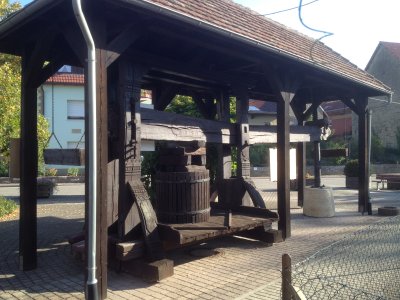
Old Grape Press For Making Wine
The picture below is another view of the grape press. Above the barrel for holding the
grapes one can see the inscription with the date, 1843.
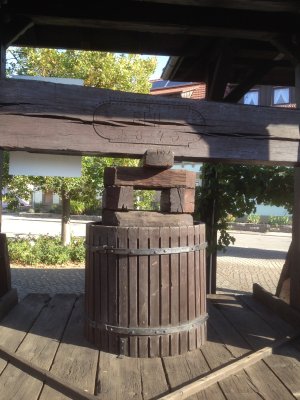
Close Up Of Barrel For Grapes On
Grape Press
The picture below shows Stan on the other side of the grape press. He's photographing some
of the grapes on the grape vine growing next to the press.
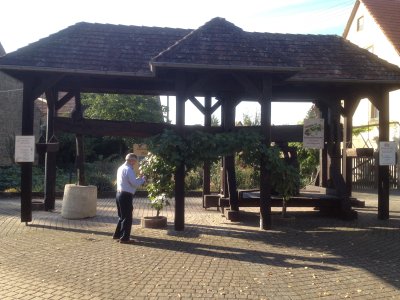
Stan Beside Grape Press
As Stan and I were admiring the grape press above and speculating about how it worked, we noticed a lady in the garden on the other side of the fence by the sidewalk next to the press. We attempted to ask the lady some questions and after a few halting attempts to communicate, she said that she would get her "Mann," who could speak English. A minute later a gentleman came out of the house beside the garden and introduced himself as Herr Dieter Velte.
Herr Velte asked us if we had questions about the press. We talked for some time. And
he answered our questions about the press. At some point he asked us if we would
like to see a vineyard. Imagine how excited we were to hear him ask us that question. We
already knew that our ancestors had worked in the wine gardens. So one of our goals for our
visit to Kürnbach was to also visit one of the vineyards and to learn about them. I'm
sure Herr Velte noticed our excitement when he offered to take us to a vineyard. We were soon
in his auto headed to the vineyard up the hill from the village. The picture below shows Herr
Velte and me in the vineyard with the village of Kürnbach in the background. The church
steeple is visible over my shoulder.
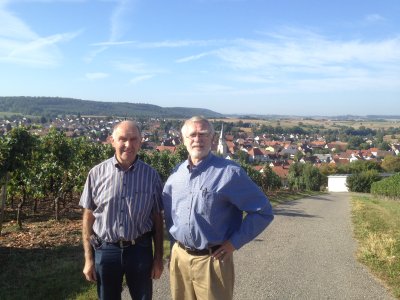
Herr Dieter Velte, The Wine Gardner,
And Lynn E. Garn
The picture below shows a view of the village of Kürnbach from the vineyard on the hill
above the village. The steeple of the church is plainly visible.
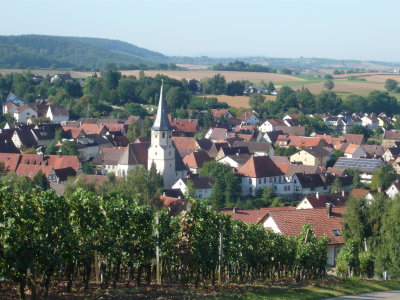
A View Of Kürnbach From The Vineyard
The picture below is another view of the village of Kürnbach from the vineyard on the hill
overlooking the village. One can see the rows of grape vines in the vineyard. One can also see the
steeple of the church in this view.
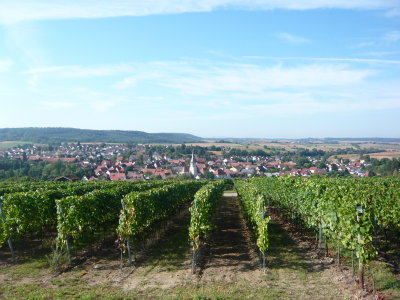
View Of Kürnbach Through Rows Of Grape Vines
The picture below is of Stan and me in the vineyard. It was at this point while we were standing
there in the vineyard that I started thinking about how our ancestors must have walked this same ground
and picked grapes from vines growing all around the place where we were standing. I had once heard
from Philip Graham Garn, who wrote books in 1985 about the Garn family of Utah and their ancestors, that
Phil's ancestor, Philip James Garn brought grapes to Utah from Ohio when he made the journey to Utah in
1855. At one time Philip Graham Garn had grape vines that came from cuttings of vines brought to Utah
by his ancestor. Philip Graham Garn reported that the family tradition held that the grapes had been
brought to Ohio from Pennsylvania by the Garns and that they may even have been brought to Pennsylvania
from Europe by the Garns or Gerns as we now know the name was spelled in Germany. As I was standing in
the vineyard, I couldn't help wondering if those grapes that Phil Garn once had at his
home in Salt Lake City may have been "descendants" of grapes from Kürnbach and if they were the
same variety as those around us in the vineyard.
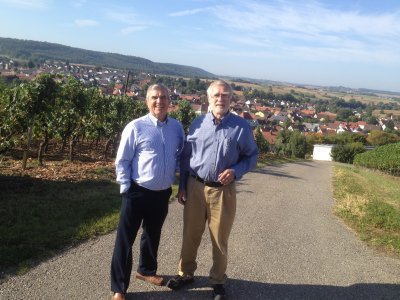
Stan And Me In The Vineyard
This picture shows some of the grapes in the vineyard. These undoubtedly were the Muskat Bleu
variety that were pictured and discussed above. Every vine in the vineyard was loaded with grapes
just the way this vine was loaded. We asked Herr Velte when the grapes would be harvested. He told
us they would start the following week. And he told us he expected a good harvest. Looking at the
grapes on those vines, it sure looked like he was going to get a lot of grapes in his harvest.
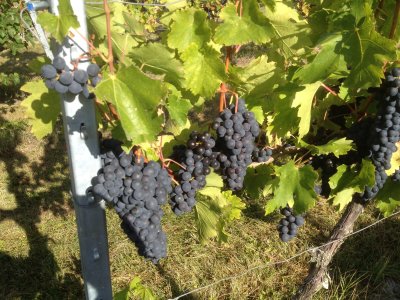
Grapes In Dieter Velte's Vineyard
The quantity of grapes in a grape harvest is not the only thing that affects how good the harvest will be. Another factor is the sugar content of the grapes. Herr Velte brought along with him to the vineyard a Brix Meter or refractometer to measure the sugar content of his grapes. The pictures below show Herr Velte rubbing juice from a grape onto the instrument and then looking through it. The sugar content of the grapes affects the index of refraction of the juice. When a thin layer of the juice is viewed through a refrectometer, a line appears between a dark region and light region of the little display. The position of this line depends on the index of refraction of the juice. Superimposed on the display and line is a scale with numbers that can be read to indicate the sugar content.
Herr Velte was quite happy with the sugar content of his grapes. And he soon pulled a plastic
bag from his pocket and started cutting bunches of grapes from the vines
and putting them in the bag. Since he had been cutting lots of grapes from those vines, we became
a bit concerned that someone might become unhappy that we were there in the vineyard messing with
the vines and taking grapes. So Stan asked Herr Velte, "Who owns these grapes?" Herr looked up
with a big smile and said, "I do. This vineyard is my hobby." At that point we were happy that
he was putting those grapes in the bag for us.
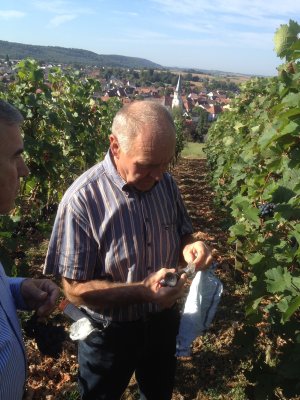
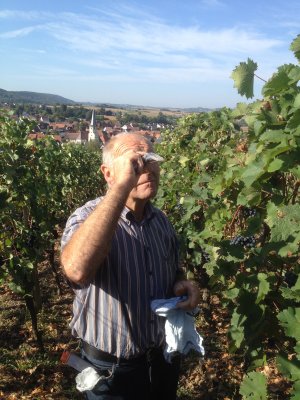
Herr Velte rubbing grape juice on his Brix Meter
Herr Velte looking through his Brix Meter
When we left the vineyard, Herr Velte drove us around the outskirts of Kürnbach and
came into the village from a different direction. He wanted to
show us more of the wine making process. So he took us to the Winzergenossenschaft Kürnbach
or Kürnbach Wine Growers Cooperative. The building in the picture below is the Cooperative.
To the right of the building one can see a wagon. An aluminum bin can be seen between the wagon
and the building.
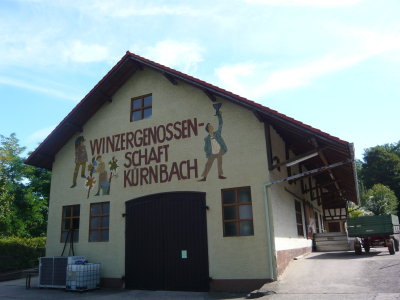
Winzergenossenschaft Kürnbach
The picture below is another view of the Winzergenossenschaft Kürnbach or Kürnbach
Wine Growers Cooperative. On the left is the green wagon that we pointed out in the previous image.
And between the wagon and the building one can see the aluminum bin that we noted above.
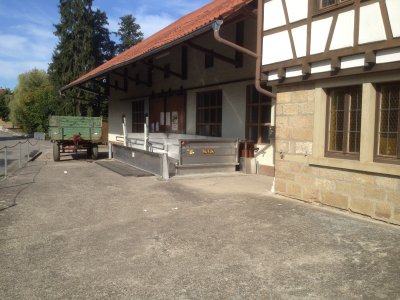
Another View Of The
Winzergenossenschaft Kürnbach
Pictured below is the aluminum bin at the Winzergenossenschaft Kürnbach or Kürnbach
Wine Growers Cooperative. One can immediately see that it is more than an aluminum bin. It is the
modern grape press used by the members of the Cooperative. During harvest time wagons pull up beside
the bin and dump their loads of grapes. The screw in the trough turns and crushes the grapes letting the
juice flow out the bottom of the press.
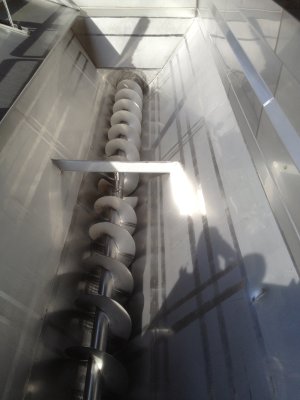
Modern Grape Press
When we left the Winzergenossenschaft Kürnbach, Herr Velte took us back to his home and
into his wine celler. There he had lots of bottles of wine. The bottles did not have labels. He pulled
a bottle off of the shelf and handed it to us and told us it was Schwarzreisling wine. We were delighted.
Initially I planned to bring it home with me. However, we had packed light with only carry-on luggage.
And when we realized that a large unlabeled bottle of liquid would certainly raise suspicions at the
airport and would certainly be confiscated by the Transportation Security Administration, we decided
that we needed to drink the wine while still in Germany. A few days later we were at the Hotel Anna
restaurant near Ramstein that Stan and Jan had gone to frequently during the seven years they lived
in Germany. The owner/host, Nikko, knew Stan well.
When Stan explained that we had the wine and would like to drink it at his restaurant, he brought out a
bottle opener. He didn't have any problem with us bringing our wine into his restaurant. The picture below
is of Stan with a glass of the wine and the pizza that he ordered for dinner that night.
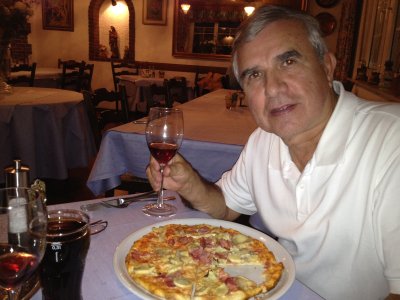
Stan Drinking Schwarzriesling Wine And Eating Pizza
The picture below shows me holding a glass of the Schwarzriesling wine. We really enjoyed
the wine. It was excellent. And it made me wish that I could buy some here in the United States.
So far I haven't found a place to buy it. But I keep looking.
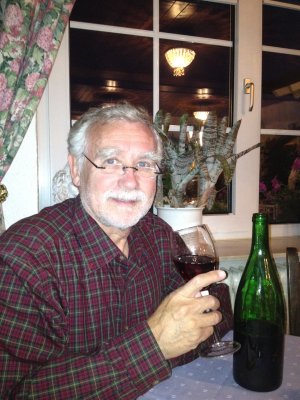
Me Enjoying Schwarzriesling Wine
Before heading for Europe, Stan, knowing that we might meet some people that could be
curious about the Garn family name, picked up a National Aeronautics and Space Administration
or NASA patch for the shuttle flight that our distant relative, U.S. Senator Jake Garn took
on flight STS-51-D aboard the Space Shuttle in 1985. Each NASA flight has a patch created for
the flight which is worn on the suits of the astronauts and is also sold as a souvenir. Stan
had an extra patch for the NASA flight that Jake Garn flew on. So Stan brought the patch along
to give to someone in Kürnbach. After Herr Deiter Velte gave us the bottle of
Schwarzriesling wine, Stan gave him the patch, which he appeared to appreciate. A photo of
one of these patches is shown below.

NASA Space Shuttle Patch With
Garn Name On It For
Astronaut Jake Garn
Before Herr Velte left the vineyard to take us to the Winzergenossenschaft
Kürnbach or Kürnbach Wine Growers Cooperative, he took us to a memorial on the hill
to the men of Kürnbach who had died in wars that Germany has fought. The picture below
shows a cross that was erected at the memorial.
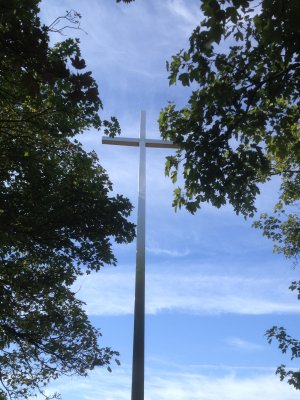
Cross At Memorial For Kürnbach War Dead
The picture below shows a large plaque with names of Kürnbach men who died in World War I.
A smaller plaque shows names of men who died in the Franko Prussian War in 1870 and 1871
between France and regions that later became Germany. Two other plaques that are not pictured
give names of men who died during or as a result of World War II between 1939 and 1947. The two
other plaques have a total of 83 names, which is a huge loss for a village that had a population
of around 2000 to 2500 people at time World War II was fought. The plaque shown below with the
names of World War I dead has 62 names, also a large loss for the village. We did not see anyone
on the list with the name Gern.
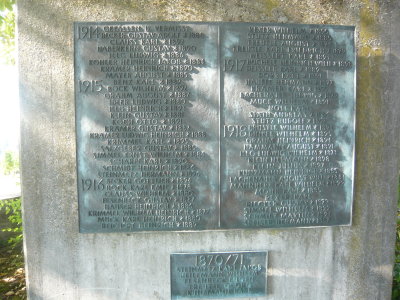
Plaque At Memorial For Kürnbach War Dead
One of the places that I wanted to visit while in Kürnbach was the village cemetery. I had seen in information about the Evangelische or Protestant Church that there was once a cemetery by the church and that it was removed and the ground terraced when renovations were made on the church. The time of the renovation appeared to be after our ancestors were in the village. So I did not hold out any hope of finding any Gerns in the village cemetery. Still, I wanted to visit just to make sure.
The picture below shows the cemetery in the foreground, the village in the middle and the vineyards and war memorial in the distance. The rows of grape vines are visible to the right of the church steeple. Just to the left of the church steeple sillhouetted against the trees that also are behind the steeple, one can see the cross in front of the Kürnbach War Memorial that was discussed above.
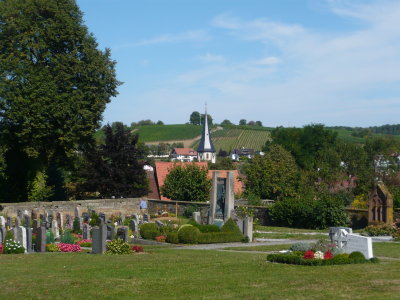 |
| View From The Kürnbach Cemetery |
The picture below shows me talking with villagers. Before visiting Germany I had heard stories
that German burial customs are much different than our customs here in the United States. And someone
I talked with in the cemetery confirmed how different the customs are. The person confirmed that burial
plots are rented more or less and that they are reused after a while. For a person who is buried alone,
the grave is maintained for 20 years before it is recycled. A couple is buried for 30 years before
their graves are recycled. And a few "family" plots are maintained for 50 years before the graves
are recycled. I was given the impression that the number of years that graves are maintained may vary
slightly from village to village but that the times graves are maintained in the Kürnbach cemetery
are representative of the times other villages maintain graves. There appears to be plenty of land in
and around these villages. So the policy doesn't appear to be influenced by the availability of land.
It has to be a choice based on long standing customs of the people. Incidentally, I did not find any
Gerns who were buried there. All of the graves I saw were newer graves whose ages fell under the
maintenance times we were told.
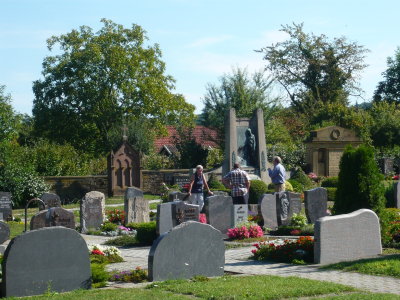
Me With Villagers At The Kürnbach Cemetery
When we were planning our trip to Kürnbach, we really hoped that we would be able to stay at the Kürnbacher Hof guest house. Knowing almost no German at the time, I hoped that someone at the Kürnbacher Hof could speak English. However, when I called and asked "Sprechen Sie Englisch," the person at the other end said, "nein." So I knew I needed to do something else if we were to stay at the Kürnbacher Hof.
Years ago, when I worked for the government, I was part of NATO research study group that was a cooperative research effort among several NATO countries, including Germany. And the place in Germany that I used to travel was Ettlingen, which is very near Karlsruhe and about 25 miles or so from Kürnbach. One of the Germans who was a member of that research group was Karlheinz Bers. I interacted with him many times over the course of work in the group. Although I had lost track of him, I checked in a German phone directory and found someone named Karlheinz Bers in Leimersheim, which is not far from Ettlingen. I wrote to him and was delighted to learn that the Karlheinz Bers of Leimersheim was the same person with whom I worked in the research group. Karlheinz kindly called the Kürnbacher Hof on our behalf and reserved rooms for us. And after meeting the Binders at the Kürnbacher Hof, I realized that if Frau Binder had answered the phone, I probably could have made my reservation. But we were grateful to Karlheinz for making sure our reservations were made correctly.
When Karlheinz learned that our family roots were in Kürnbach and that we hoped to learn
more about the family while we were there, he offered to help. We made plans to meet Sunday afternoon
and have dinner Sunday evening at the Kürnbacher Hof. Stan and I were walking in the village
when I saw them drive past us. Karlheinz must have recognized me also because his car turned around
immediately. The picture below is of Karlheinz and his wife Christine in Kürnbach.

Karlheinz And Christine Bers
Karlheinz was a big help. It is the younger Germans who are the most fluent in English. But it is
the older Germans who know the history. And Karlheinz spoke with several of the older Germans and
asked about the Gern family. Several people told him about an author and historian who was in a nearby
home for the elderly. His name was Herr Reinhard Schmid. People also said that Herr Schmid was blind
but that his mind was still sharp and that he could probably help us. I immediately recognized Herr
Reinhard Schmid as the name of the person who had written the book about the guest houses in
Kürnbach and the surrounding villages which I mentioned above.
Upon learning the location of the home where Reinhard Schmid was living, we set off to find it. Karlheinz spoke with him at length and translated for me. Herr Schmid recommended that I visit the church and speak with the pastor, a woman named Frau Ulrike Trautz. Herr Schmid said that Frau Trautz would call Herr Treutle, who was familiar with the old church records, and that Herr Treutle would help us.
One very interesting thing that Karlheinz learned from Herr Schmid and from at least one other older resident of Kürnbach that we met as we walked around the village was a story about a rhyme or ditty that the children used to say years ago that involved the Gern family. Apparently the children years ago used to say a four-word sentence that they made up with the names of four families that lived in the village. The sentence they made up was "Gern Stutz den Bock." The names of the families were, "Gern," "Stutz," "Dehn," and "Bock." One will notice that the family name, "Dehn," was changed to "den" in the sentence. The two words sound the same. So they used "Dehn" as "den" in the sentence. And "Stutz" may be "Stutze." Loosely translated, this sentence means, "I like to dock (bob or cut off) the horns of that ram (male goat)." In this sentence "Gern" is an adverb meaning, "gladly" or "with pleasure" or in this case, "I like to." "Stutz" means to "bob," "dock," or "cut off." It is implied that horns are being cut off. The word "den" means "that." and "Bock" means "ram."
This sentence had to have originated some time in the mid 1800s or before since it appears that the Gern family was gone from the village by 1900. So the ditty had to have been passed from older school children to the younger children in order for the people of the village to remember it today. I was delighted to learn of the Garn or Gern family's inclusion in this little ditty.
One of the things that Karlheinz brought from his home in Leimersheim when he came to
Kürnbach was pictures of two of the international groups that he and I had worked on. The
research study group that I mentioned before was named Research Study Group 9. Host countries always
took a photograph of the group some time during the meetings held by the group. And the photo below is
a photo of the attendees at one of the early meetings that I attended in Ettlingen, Germany, at the
Forschungsinstitut für Informationsverarbeitung und Mustererkennung, Forschungsgesellschaft
für Angewandte Naturwissenschaften which translates to something like Research Institute for
Information Processing and Pattern Recognition, Research Establishment for Applied Science.
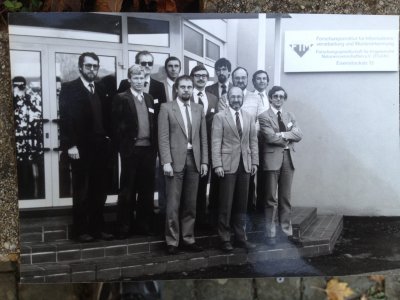
NATO Research Study Group 9,
Ettlingen, Germany, About 1985
I was surprised that I still remembered the names of most of the members of the group. The names
of the people in the picture, from left to right are: Karlheinz Bers, Germany; Stein Grinnaker, Norway;
Christian Birkemark, Denmark; John Knecht, China Lake, United States; Peter Fritsche, Germany; Lynn
E. Garn, Night Vision Lab, United States; Helmut Stengel, Germany; Manfred Bohner, RSG-9 Chairman, Germany; Leandre
Sevigny, Canada; Jean Pierre Gambotto, France; and Richard Cowderoy, England.
During the whole time I was traveling to Ettlingen, Germany, for these meetings, I did not know that my Garn ancestors had lived within about 25 miles from the place where the meetings were being held. I certainly wish that I could have visited Kürnbach when I visited Ettlingen. It was about 15 years after my last visit to Ettlingen that I learned how close the Garn ancestral home was to Ettlingen.
I was quite pleased with all of the information that Karlheinz gathered for us while we visited in Kürnbach, especially the rhyme or ditty and the information about who to talk with at the church and the suggestion by Herr Schmid that we involve Herr Treutle in our research. Karlheinz was a big help. And Stan and I enjoyed talking with his wife also. So as Karlheinz and his wife left us Sunday evening, we were looking forward to Monday morning and a visit to the church.
Monday morning around 9am we set off for the church in search of Frau Trautz, whom Herr Schmid had told Karlheinz Bers we should speak with at the church. Although a German Frau refers to any married woman in Germany, our stereotype of a Frau is an older woman. So when we approached several people working outside the gate to the residence at the church and asked for Frau Trautz, we were surprise when a young lady said that she was Frau Trautz. After explaining our reason for visiting, she said that she would call Herr Richard Treutle to see if he was available to help search the records.
Frau Trautz then opened a huge floor safe with a combination lock and showed us a row of very
old books, which were the old church records. When Herr Treutle arrived, Frau Trautz explained
our interests whereupon Herr Treutle pulled several books out of the safe. The picture below shows
Frau Trautz and Herr Treutle as we were starting our search among the old books. Herr
Treutle did not speak English and Frau Trautz kindly translated to get us started.
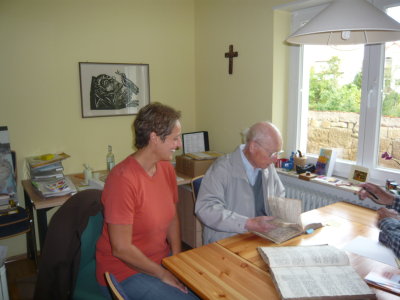
Frau Trautz And Herr Treutle
Before even going to Kürnbach, I had seen microfilms of some of the records there. The
Mormon Church had filmed them and added them to their library many years ago. So I had seen pictures
of some of the records on the microfilms already. And I had used some of them in my book on the Garn
family. However, I really wanted to see the books themselves. One thing that I was not
expecting however was to see another book that the Mormon Church did not microfilm. That was the
Kürnbach Families Book or, "Kürnbach Familien Buch," as shown in the photo below.
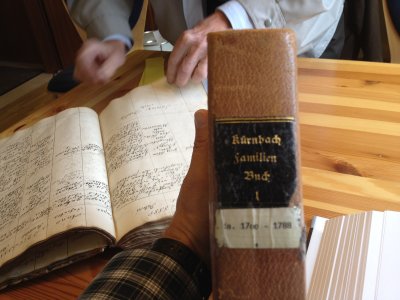
Kürnbach Familien Buch
I had never seen this book with its lists of families all grouped under the name of the
head of the family. I quickly searched for my Gern ancestors. I found the families of Johann Adam
Gern and Conrad Gern. I was pleased to discover that I had not made any mistakes in the family
groups that I compiled from the other records.
The photo below shows Herr Treutle cross checking names between the Kürnbach Familien
Buch and the books of vital records.
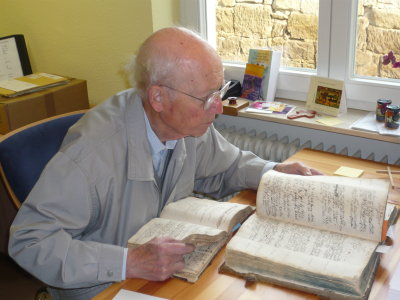
Herr Treutle At Work
I wish I could remember what discovery Herr Treutle made that caught our attention. This
picture shows him summoning us to see his discovery.
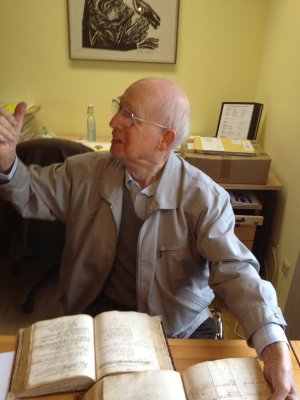
Herr Treutle Calling Us To See A Record
This picture shows Herr Treutle and me at work at the table in Frau Trautz' study at
the church.
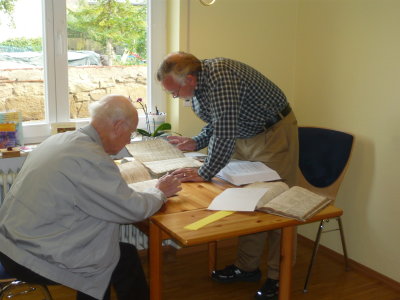
Herr Treutle And Lynn Garn At work
In the photo below I am photographing some records in the Kürnbach Familien Buch as
Herr Treutle looks on. I was grateful that he was so familiar with the records and could point
me to them quickly.
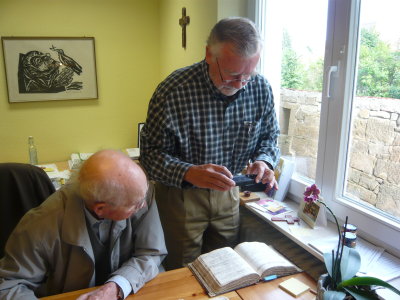
Photographing Records In The Kürnbach Familien Buch
Before visiting Kürnbach I had known of John Adam Treutlen, Kürnbach's famous son who
moved to Georgia in the United States and became the first elected governor of the state after the
United States gained independence from Great Britain. At some point Herr Richard Treutle wanted to know
if I had ever heard of the Kürnbach resident who later became governor of Georgia. He was quite
pleased that I already knew the story. I had already suspected that Herr Treutle was somehow related
to the governor. So I asked him. It turns out that Herr Treutle's ancestor, a Philip Treutlen I believe,
was a brother of Michael Treutlen, the father of John Adam Treutlen, the governor of Georgia. The photo
below is of Herr Treutle and me trying to discuss his relationship to the governor.
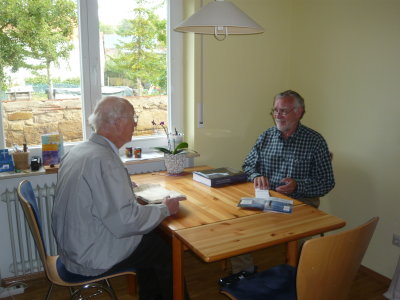
Herr Treutle And Lynn Garn
Th photo below shows Stan holding one of the old church record books with births and christenings
of our Gern ancestors.
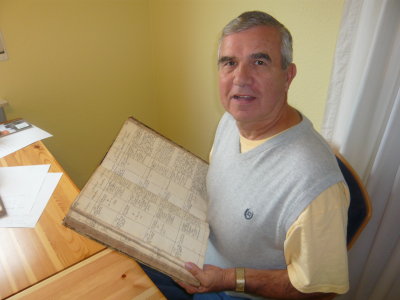
Stan With Old Church Record Book
The photo below shows me pointing to a birth and christening record in the old church record
book. The record I am pointing to is that of Johannes Gern, who was born on 3 March 1738.
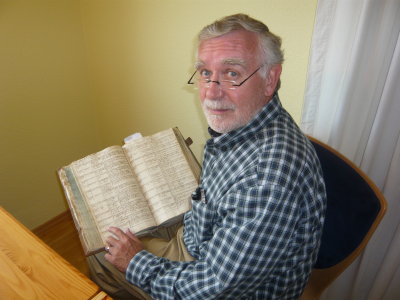
Me Pointing To The Birth And Christening Record Of Johannes Gern, 1738-1808
The photo below shows me pointing to a birth and christening record in the old church record
book. The record I am pointing to is that of Conrad Gern, who was born on 4 March 1748. Conrad was
a younger brother of Johannes Gern whose record is mentioned in the photo above.
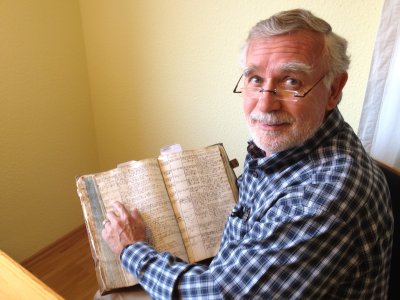
Me Pointing To The Birth And Christening Record Of Conrad Gern, 1748-~1810
The photo below shows me pointing to a birth and christening record in the old church record
book. The record I am pointing to is that of another Johannes Gern, who was born on 16 August 1780.
He was the son of Conrad Gern whose record is mentioned in the photo above.
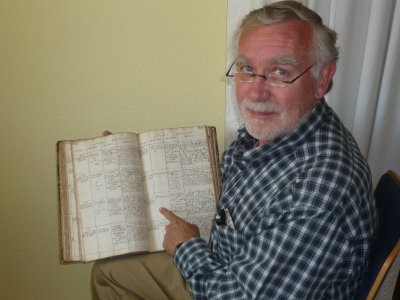
Me Pointing To The Birth And Christening Record Of Johannes Gern, 1780-1873
I'll note here that the Johannes Gern who was born in 1738, whose record is shown a couple
of photos above, had a granddaughter named Susanna Garn. This Susanna married her second cousin
Abraham Garn, who was the grandson of Conrad Gern above. Abraham's father was the Johannes Gern
who was born in 1780 whose record is shown above. Abraham and Susanna Garn's son Martin Garn
was Stan and my great-grandfather.
At the end of several hours of research Herr Treutle and I were pleased with what we
had accomplished. I wanted another picture of the two of us, which is shown below.
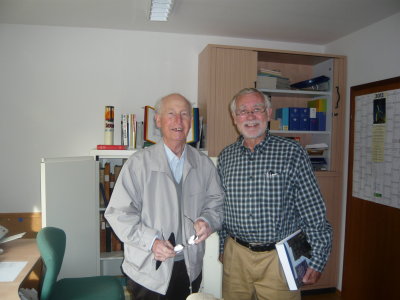
Herr Treutle And Me
The picture below shows Stan, Herr Treutle, Frau Trautz and me in front of the gate
to the minister's home at the church. Frau Trautz is holding a copy of my book on the Garn
family.
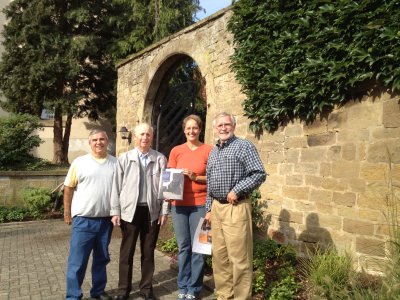
Stan, Herr Treutle, Frau Trautz And Me
At this point I feel compelled to note an error that some people have made when recording geographical information about Kürnbach for family tree records, particularly on the Ancestry.com web site. For some reason or other people have been reporting that Kürnbach is located in the Biberach District of the Baden Württemberg State of Germany. This is WRONG! Biberach is a district located in the eastern part of Baden-Württemberg. As noted above, the GPS coordinates of Kürnbach are 49.078104N, 8.845232E. And it is obvious that Kürnbach is located in the Karlsruhe District, a District on the western side of the Baden Württemberg State of Germany.
There happens to be a "Museumdorf Kürnbach" located in Bad Schussenried, which is in the Biberach District. But this is just a museum that shows a small village from the past much as the Plimoth Plantation in Plymouth, Massachusetts, shows a village like the one that the Pilgrims might have lived in. The museum in Bad Schussenried has absolutely nothing to do with the Kürnbach church where the Gern records are located.
I actually asked several people in Kürnbach to name the district where Kürnbach is located and all reported Karlsruhe as the district. So if you run across a record that reports Kürnbach, Biberach, Baden-Württemberg, Germany, as the way to reference the place where the Gerns originated in Germany, you can know that the people citing Biberach as the District are wrong and have not done their homework.
As mentioned earlier, our visit to Kürnbach was the highlight of our trip to Europe. I would love to visit the village again.
To contact me by mail, write:
Mr. Lynn E. Garn
12210 Redwood Ct.
Woodbridge, VA 22192-1611
USA
Or email me at:

Updated on 15 February 2013